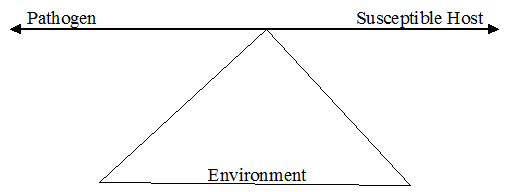The characteristics of a disease are largely dependent on the relationship between the environment, the disease causing microorganism (pathogen) and a susceptible host. Health; it must be noted is a state of equilibrium or balance between susceptible host (the individual) and the agent (pathogenic microorganism).
The features of host, environment, and agent (disease cause) are referred to as the “epidemiologic triad” and they are always taken into consideration when trying to unravel and contain the outbreak of an infection/disease within a particular community/population. The environment brings the susceptible host and the pathogen together.
Each of these contending variables (the environment, susceptible host and the pathogen) influences one another and the poor health or good health of the susceptible host is directly or indirectly dependent on the maintenance of a balance amongst the trio (i.e. the pathogen, susceptible host and the environment).
These factors can either be intrinsic or extrinsic depending on the one being investigated. The environment, pathogen and a susceptible host are always interacting amongst each other in an array of multifaceted ways which eventually results to the production or non-production of a disease/infection.
These factors are examined in the course of an epidemiological study (e.g. analytical study) in order to decipher the cause of a particular disease. An imbalance amongst the susceptible host factors, environment and the pathogen (Figure 1) might eventually result to an epidemic, endemic disease or even a pandemic.

ENVIRONMENTAL FACTORS THAT INFLUENCE A DISEASE
The environmental factors are those factors which create the chance for exposure of susceptible individuals to a particular infection in a given community. These environmental factors that influence the distribution of disease or infection in a given area include:
- Biological factors e.g. mosquitoes, houseflies and other vectors that help in transmitting the pathogen from the environment or other sources to a susceptible host.
- Physical factors e.g. climatic conditions, surroundings of homes, water, food and hospitals, and the soil.
- Socio-economic factors e.g. personal hygiene, public sanitation, overcrowding, availability of public conveniences such as toilets, and availability of health clinics.
References
Aschengrau A and Seage G.R (2013). Essentials of Epidemiology in Public Health. Third edition. Jones and Bartleh Learning,
Aschengrau, A., & G. R. Seage III. (2009). Essentials of Epidemiology in Public Health. Boston: Jones and Bartlett Publishers.
Bonita R., Beaglehole R., Kjellström T (2006). Basic epidemiology. 2nd edition. World Health Organization. Pp. 1-226.
Brooks G.F., Butel J.S and Morse S.A (2004). Medical Microbiology, 23rd edition. McGraw Hill Publishers. USA.
Castillo-Salgado C (2010). Trends and directions of global public health surveillance. Epidemiol Rev, 32:93–109.
Centers for Disease Control and National Institutes of Health (1999). Biosafety in Microbiological and Biomedical Laboratories, 4th edn, Washington DC: CDC.
Gordis L (2013). Epidemiology. Fifth edition. Saunders Publishers, USA.
Guillemin J (2006). Scientists and the history of biological weapons. European Molecular Biology Organization (EMBO) Reports, Vol 7, Special Issue: S45-S49.
Halliday JE, Meredith AL, Knobel DL, Shaw DJ, Bronsvoort BMC, Cleaveland S (2007). A framework for evaluating animals as sentinels for infectious disease surveillance. J R Soc Interface, 4:973–984.
Lucas A.O and Gilles H.M (2003). Short Textbook of Public Health Medicine for the tropics. Fourth edition. Hodder Arnold Publication, UK.
MacMahon B., Trichopoulos D (1996). Epidemiology Principles and Methods. 2nd ed. Boston, MA: Little, Brown and Company. USA.
Nelson K.E and Williams C (2013). Infectious Disease Epidemiology: Theory and Practice. Third edition. Jones and Bartleh Learning.
Porta M (2008). A dictionary of epidemiology. 5th edition. New York: Oxford University Press.
Rothman K.J and Greenland S (1998). Modern epidemiology, 2nd edition. Philadelphia: Lippincott-Raven.
Rothman K.J, Greenland S and Lash T.L (2011). Modern Epidemiology. Third edition. Lippincott Williams and Wilkins, Philadelphia, PA, USA.
Discover more from #1 Microbiology Resource Hub
Subscribe to get the latest posts to your email.



Quite insightful!